Introduction: What’s All the Buzz About Claude 4?
Let’s cut to the chase – Claude 4 is the latest AI model from Anthropic, and it already changes heads in the technical world. If you are in AI, coding, or want an assistant who can handle the heavy lifting, Claude 4 can be the game-changer you are waiting for. But what makes it so special? Why should you care? And how does it stack up to competition like ChatGPT? This is what we should unpack here.
I have dug into the AI tool for some time, and I am excited to share what I have learned about Claude 4. In addition, I will explore with you some common questions, free equipment and resources to start. Towards the end, you will know if the Claude 4 AI is the AI assistant you need. Let’s dive

What Is Claude 4?
OK, let’s start with the basics. Claude 4 is the latest family of the anthropic of the AI model launched on May 22, 2025. It consists of two powerhouses: Claude Opus 4 and Claude Sonnet 4. These models are designed to handle complex tasks, which require deep thinking, whether it’s analyzing massive datasets, writing code, or even interpreting images.
Think of Claude 4 as your super-smart assistant, who not only answers questions but also solves problems. This is not about spitting general answers – it’s about delivering real value. Here’s a quick rundown of what makes it stand out:
- Release Date: May 22, 2025, which marks a significant leap from the first Claude models.
- Models: Opus 4 (premium, for complex tasks) and Sonnet 4 (versatile, accessible to free users).
- Capabilities: Advanced reasoning, vision analysis, code generation, and multilingual processing.
It is designed for those who need AI, who can keep their ambitions, whether you are a developer, analyst or content creator. Let’s break down its features to see why it makes such a stir.
Features of Claude 4: Why It’s Worth the Hype
So what can Claude 4 do? Here are the following broken pieces to cut to a shear size:
- Advanced Reasoning: This isn’t your average chatbot. Claude 4 can handle complex cognitive tasks, like analyzing large datasets or executing long-horizon tasks. It’s like having a PhD-level thinker on speed dial.
- Vision Analysis: Need to make sense of a graph or handwritten note? Claude 4 can transcribe and analyze almost any static image, turning visual data into actionable insights. For example, upload a sales chart, and it can extract trends or even generate code to visualize it.
- Code Generation: Developers, listen up. Claude 4 is tuned for programming. It can write, debug, and even generate entire websites in HTML and CSS. It integrates with IDEs like VS Code and JetBrains, and its Artefacts feature lets you preview code outputs in real-time.
- Multilingual Processing: Breaking language barriers is a breeze. Claude 4 can translate languages in real-time, help with grammar, or create multilingual content. Perfect for global teams or content creators targeting diverse audiences.
- Performance: This AI can work autonomously for hours, think a full workday. It’s designed to push the limits for coding and AI agents, handling tasks that would take humans days.
- Security and Reliability: With SOC 2 Type II certification and HIPAA compliance options, Claude 4 is secure for sensitive data. Plus, it has very low hallucination rates, so you can trust its outputs.
- Tool Usage: Claude 4 can use multiple tools (like search engines) in parallel, alternating between reasoning and tool use. It even has “memory” capabilities, saving key facts to build knowledge over time.
These features are not just buzzwords – they are tools you can work with that can change it. But how does Claude 4 stack up against the AI everyone’s talking about, ChatGPT?

Claude 4 vs. ChatGPT: Which One’s Better?
Let’s get real: ChatGPT has been the king of AI assistants for years, but Claude 4 is here to challenge the throne. Based on recent insights, here’s how they compare:
| Feature | Claude 4 | ChatGPT (GPT-4o) |
|---|---|---|
| Excels with Artefacts feature for real-time code previews | Up to 200K tokens, handles 100+ page documents | 32K tokens, struggles beyond 50 pages |
| Coding | Excels with the Artefacts feature for real-time code previews | Strong, but less integrated for developers |
| Conversational Tasks | Precise, but less conversational | Better for casual chats, voice features, and web browsing |
| Image Analysis | Strong in interpreting complex images like charts | Good at image generation, slightly less precise for data extraction |
| Pricing | Sonnet 4: Free (limited); Opus 4: $15–$75/million tokens | Free tier (GPT-3.5); $20/month for GPT-4o |
- Reasoning and Long-Context Tasks: Claude 4 is likely the winner here. Its massive context window (200K tokens, expandable to 1M for specific cases) makes it ideal for processing long documents or complex workflows. ChatGPT’s 32K token limit can’t keep up with that.
- Coding: Claude 4 seems to have an edge, especially with its Artefacts feature, which shows code outputs in real-time. For example, you can write a script and see the results instantly, making it a developer’s dream. ChatGPT is great for coding help, but it feels less seamless.
- Conversational Tasks: ChatGPT shines in casual, conversational tasks. It has voice chat and real-time web browsing for fact-checking, which Claude 4 lacks. If you need quick answers or a chatty AI, ChatGPT might be better.
- Image Analysis: Both are multimodal, but Claude 4 appears to excel at extracting data from complex images like graphs. ChatGPT can generate images, but Claude 4 feels more precise for analysis.
So, which one is better? It depends on. If you need deep reasoning, long-context tasks, or coding support, Claude 4 is your best choice. But for everyday chat or tasks needing web access, ChatGPT might still be the go-to.
Use Cases for Claude 4: Where It Shines
Who should be using Claude 4? There are some real-world scenarios here where it can make a difference:
- Developers: Imagine debugging a complex codebase or generating a website from scratch. Claude 4 can write, edit, and debug code, saving you hours. For example, I used it to create a simple HTML/CSS landing page in minutes – it even suggested optimizations.
- Data Analysts: Got a massive dataset to analyze? Claude 4 can crunch numbers, extract insights, and even visualize data. It’s like having a data scientist on call.
- Content Creators: Need to write an article or create multi-lingual content? Claude 4 can brainstorm ideas, expand outlines, or translate content instantly. I tested it with a blog post outline, and it turned it into a polished draft in no time.
- Researchers: If you’re sifting through long documents, Claude 4’s context window is a lifesaver. It can summarize 100-page reports or extract key facts without missing a beat.
- Educators: Create interactive learning materials, translate content, or analyze student work. Claude 4 can even help with grading by spotting patterns in answers.
FAQs: Answering Your Burning Questions
Here are some common questions about Claude 4, with direct answers given:
What’s the difference between Claude, Opus 4 and Sonnet 4?
Opus 4 is a premium model for complex, long-running tasks, while the Sonnet 4 is more accessible, but still powerful. Think of Opus 4, that heavy-duty truck and Sonnet 4 as the speedy sedan.
How does Claude 4 handle coding tasks?
It is designed for programming, which has features such as code writing, debugging and IDE integration. Knowing objects allows you to see the code output in real time, making it the best friend of a developer.
Is Claude 4 better than ChatGPT for all tasks?
Not always. Claude 4 excels in reasoning, coding, and long-context tasks, but ChatGPT is better for conversational tasks and web browsing. Pick based on your needs.
What are the pricing options for Claude 4?
Sonnet 4 is free with limits, while Opus 4 is for paying users. API pricing is $3–$15/million tokens for Sonnet 4 and $15–$75/million tokens for Opus 4. (That’s about 750,000 words—more than enough for most projects.)
Conclusion: Is Claude 4 Worth It?
Look, Claude 4 is not just another AI – this is a leap forward. If you need an AI that can handle complex tasks, analyze images or code like a pro, that is worth checking out the Claude 4. This is not perfect for all ease. ChatGPT still has its strengths, but high-level reasoning and long-running tasks, it is difficult to defeat it.
Don’t just take my word for this. Try Sonnet 4 for free on Claude.ai and see what it can do. If you look seriously at AI, Claude 4 can just be the tool you are waiting for.
Additional Resources
- Try Claude 4 for free at Claude.ai.
- Learn more at Anthropic’s Claude Page.
- Check out Claude Documentation for technical details.
- For more AI insights, visit daytalk.in.

